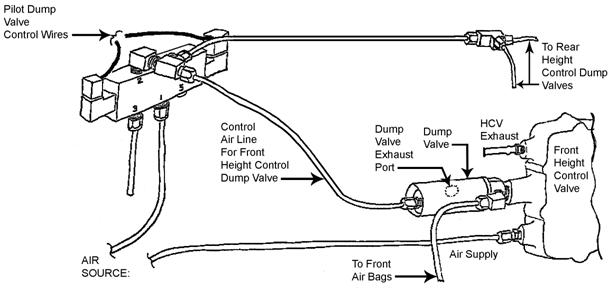CHAPTER 2 – Basic Air Suspension
2-1 What is an Air Suspension?
2-2 Components of the Air Suspension.
2-2.1 The Air Supply
2-2.2 Air Bags
2-2.3 Height Control Valves
CHAPTER 3 – How the Air Suspension Functions
CHAPTER 4 – Pilot Operated Suspension Air Dump
CHAPTER 1 – PREFACE
IMPORTANT: This section is not meant to qualify you to work on air suspensions or air brake systems. It is only meant to give you a basic knowledge of how an air suspension works. You should not work on the actual suspension or brake components without the authorization and supervision of the vehicle, chassis or suspension manufacturer.
It is important to understand air suspensions because there is a direct interaction between the air suspension and the leveling of a vehicle. In fact, there are leveling systems available that use the vehicle air suspension to do the leveling. The HWH® Active Air Suspension System actually controls the air suspension of a vehicle while the vehicle is traveling. You must understand the air suspension before dealing with our systems that are installed on vehicles with an air suspension.
At this time it is important to note that the following discussions are generic in nature. There are many different types and manufacturers of air suspensions and many different ways they are put together. Even different chassis’s built by the same manufacturer can be different in some ways. There are different air bag, air tank and valve arrangements. When dealing with suspension issues, it is critical that you obtain plumbing and wiring diagrams for the specific chassis that you are working on.
CHAPTER 2 – BASIC AIR SUSPENSION
2-1 What is an Air Suspension?
An air suspension supports the vehicle on the axles with an arrangement of air bags instead of some type of steel spring, leaf, or coil, or some type of torsion spring arrangement. The air bags are sometimes referred to as air springs or bellows. Suspensions that have steel or torsion springs that are supplemented by the use of air bags are not considered air suspensions. There are combination systems that have both air and steel springs. Usually the air suspension components are used on the rear of the vehicle. Depending on the situation, this type of air suspension will probably have to be dealt with for leveling purposes.
Normally, the air suspension is just one part of the air system on the vehicle. Most (but not all) vehicles with an air suspension also have air brakes along with other equipment that may be operated with air. Any of these other systems can cause problems with the air suspension. Other air systems including the brake systems in general, will not be discussed in this school. It is important to understand that on vehicles with air systems, especially with air brakes, manufacturers must follow specific regulations when designing their air systems. The brake system will always be the main concern for the air system. There will be safety features installed in the system that make the brake system the main priority for the air system. AGAIN, I CANNOT STRESS ENOUGH THE IMPORTANCE OF CONTACTING THE VEHICLE, CHASSIS, OR SUSPENSION MANUFACTURER BEFORE ATTEMPTING TO DEAL WITH A SUSPENSION OR BRAKE ISSUE.
2-2 Components of the Air Suspension.
An air suspension has three basic components. The air supply, the air bags, and the height control valves. As stated before, there are many different types of these components and different arrangements of how these components are used. In the following section, we will discuss several different arrangements of these components but this is by no means a complete discussion of all of the possible arrangements. Except for the Active Air System, the components we will discuss in this section are not manufactured by HWH®. Whenever you are working on an air suspension, you must deal with the suspension manufacturer not HWH CORPORATION.
2-2.1 The Air Supply. The air supply is engine air compressor, the air tanks, air valves, and air lines.
The engine air compressor supplies air for every piece of air equipment on the vehicle. The maximum pressure supplied by the compressor varies. For many years, the air supply was maintained around 120 to 125 psi but on some newer, larger vehicles this has been increased to 135 psi. Always refer to the vehicle manufacturer to obtain this figure and do not change it without the authorization of the vehicle manufacturer. There will be dash gauges that will supply system pressure information but all vehicles have what we refer to as a “pop off valve”. You can hear the valve “pop off” when the system reaches the maximum air pressure.
The air supply is maintained through an arrangement of air tanks. Air tank arrangement is one thing that varies greatly between different air systems. I have seen systems with one tank that has primary and secondary compartments built in, and systems with some type of main, secondary or auxiliary tank for every component of the system, as many as 10 to 12 different tanks. The terminology for these tanks varies greatly also. There are primary tanks, secondary tanks, wet tanks, auxiliary tanks, front brake tanks, rear brake tanks, and ping tanks to name some of them. No mater how many there are or what they are called, they all do basically the same thing, they store air for the different systems on the vehicle.
There are different valves used in the air systems also. The main valves that we deal with when working on our HWH® systems are check valves and the system protection valve. Air check valves are like hydraulic check valves, they only allow the air to flow in one direction. They are normally used to keep one part of the air system from back feeding another part of the system. The other valve that influences our equipment is the system protection valve. The system protection valve is installed on one of the system air tanks and is used to isolate the brake air supply from every other air system on the vehicle, including the suspension. When system air pressure drops to a specific point, usually about 65 to 75 psi, the protection valve closes, isolating the brake system from the suspension and other systems on the vehicle. This allows the brake system to maintain a minimum air supply for emergency situations. Consult the vehicle manufacturer for specific details and regulations concerning system protection valves.
Air system air lines and fittings also vary in size, color, and ratings. Although there are suggested standards for air line colors when dealing with specific chassis manufacturers, there does not seem to be any governing regulations covering air line colors. Air lines and fittings do have to be rated for their particular use. As with everything else, refer to the vehicle manufacturer for information concerning colors and ratings for air lines and fittings.
2-2.2 Air bags. Air bags are simply a rubber bladder that holds air. Air bags are also referred to as air springs or bellows. The air bags are located between the frame of the vehicle and the vehicle axles. Air bags are rated for weight and pressure capacities.
Air bag placement and arrangements vary amongst chassis manufacturers. At the very least, there will be one air bag for each side of each axle in the vehicle. There can be two air bags for each side of the axles but I have never seen a tag axle with more that one bag per side. Some manufacturers use two air bags for each side of the drive axle and some use two air bags for each side of the drive and front axles. Space between air bags for side to side placement also varies. Some place the air bags outboard as far as they can and some have the bags closer together. When two bags per side are used, one will be in front of the axle and the other behind the axle. Again, spacing can vary.
Most air bags will have some device such as a cone that keeps the air bag from being crushed or damaged when fully deflated. Inflating air bags is limited to the available air pressure to the suspension system. This is why the relief setting of the engine air compressor should not be changed. How much lift the air bags will have varies with vehicles and air bags, but the average lift the air bags will supply, when maximum available system air pressure is used, is between 5½ and 6½ inches from a totally deflated state.
2-2.3 Height Control Valves. The height control valves (HCV from now on) are kind of the brains of the system. They dictate how much air is in the air bags. This dictates the height the vehicle sits at, thus, Height Control Valve. Most HCVs are mechanical valves but electronic HCVs are available. The HCV is mounted to the frame of the vehicle. An L shaped linkage attaches the HCV to the axle. As the axle moves up and down in relationship to the frame, the linkage moves the valve or electronic mechanism. With mechanical valves, there is an air line from the air supply to the HCV. There is an air line from the HCV to the air bag or bags+ that it controls. The HCV also has an exhaust port. When the connecting linkage moves up, the HCV connects the air supply to the air bag(s), inflating the bag(s). When the connecting linkage moves down, the HCV connects the air bag(s) to the exhaust port, deflating the bag(s). This controls the height of the vehicle. If the HCV is electronic, as the linkage moves, the sensors in the HCV send information to an electronic control. These controls will open or close air solenoid valves as needed to inflate or deflate the bags.
There are two basic styles of mechanical HCVs, the instant response valve (IR valve) and the delay valve. These names are accurate descriptions of how the valves react. The IR valve will start to inflate or deflate the air bags as soon as the valve activating lever moves. The delay valve has a slight delay when the activating lever moves before inflating or deflating the air bags.
The number and arrangement of HCVs used on a suspension varies a little. There are normally three HCVs used on a suspension. Either there is one for the front axle and two for the rear, (most common arrangement) or some use two on the front axle and one on the rear. A few chassis have been done with one HCV for each side of the front and rear axles, a total of four, but this would not be very common. Vehicles with a tag axle use regulated air or tie the tag air bags to the driver air bags to control the tag air bags. Although it may be done, I know of no one using HCVs to control the tag axle air bags.
The following diagrams show the basic mounting of a HCV and several air bag and HCV arrangements.


CHAPTER 3 – HOW THE AIR SUSPENSION FUNCTIONS
Before explaining how the air suspension functions, there are two important things you need to understand. The first thing is the term “ride height”. Ride height is simply the distance between the frame of the vehicle and the vehicle axles that the vehicle rides at. Ride height is determined by the vehicle or chassis manufacturer. Ride height varies between vehicles and manufacturers. Ride height information must be obtained from the vehicle or chassis manufacturer. The manufacturer will supply the correct measurements and measuring points on the chassis. An example would be: Ride height should be seventeen inches measured between the center of the top shock mounting bolt to the center of the bottom shock mounting bolt. Remember, this is only an example of what the ride height information may be. The second thing you must understand is that air is highly compressible. What this means is the frame of the vehicle will move up or down (without adding air to or exhausting air from the air bags) when weight is removed or added to the vehicle. Although this is true of any suspension, air, spring or torsion, vehicles with a spring or torsion suspension will remain raised or lowered when weight is removed or added. Because of the height control valves, vehicles with air suspensions should always remain at the proper ride height. The ride height for other suspensions will change when weight is added or removed. Also, vehicles with an air suspension will not “settle” with age as a spring or torsion suspension will.

Weight can be added or removed from a vehicle or a side or end of a vehicle in different ways. Simply filling a water or fuel tank adds considerable weight to the vehicle. Draining those tanks removes weight from the vehicle. A more subtle change in weight can be caused by movement of the vehicle. When a vehicle leans, the suspension transfers weight from one side or end to the other. This adds or removes weight from different points on the suspension. The compressibility of air allows the vehicle to move up or down on the frame as the weight shifts without adding or removing air from the bags. This brings us to:
How the air suspension functions. The vehicle is supported on the frame with an arrangement of air bags. The vehicle air system, engine air compressor, tanks, lines, etc., supplies air to the height control valves (HCV) mounted to the frame of the vehicle. The height control valves are connected to the air bags with an air line. The linkage which connects the HCVs to the axles rotates the HCV valving as it moves up and down. When weight is added to the vehicle or transferred through the suspension of the vehicle, the air in the air bag(s) is compressed, the frame moves closer to the axle. This forces the HCV linkage up. As the linkage moves up, the valving of the HCV connects the air supply to the air bag(s). The added pressure and volume inflates the air bag(s), causing the frame to move away from the axle. As the frame moves back to the proper ride height, the HCV linkage moves to the neutral position. This moves the valving away from the air supply and locks the air in the air bag to maintain the proper ride height. As weight is removed from the vehicle or the suspension shifts weight away, the existing pressure in the air bag(s) can push the frame away from the axle. The HCV linkage is pulled down. This connects the air bag(s) to the HCV exhaust port. As air is exhausted from the air bag(s), the frame lowers back down towards the axle. As the linkage moves up to the neutral position, the exhaust port is closed and the air is again locked in the air bag(s), maintaining proper ride height.
These three drawings show a schematic example of the height control valve in the neutral position, inflate position and deflate or exhaust position.

CHAPTER 4 – PILOT OPERATED SUSPENSION AIR DUMP
A suspension air dump is used to exhaust the air from all of the suspension air bags. This is done for different reasons, such as kneeling, the vehicle down for entrance accessibility or to use a leveling system. (This is explained in detail in “Air Suspensions and HWH®”, part of the HWH® Online Technical School.) The pilot operated suspension air dump is the most common suspension dump system used at this time. The basic components of the pilot air dump system are the pilot operated control valve and the individual dump valves, one on each height control valve. You also have the control switch, wiring harnesses for the control valve along with air lines and fittings to connect the control valve to the dump valves. The pilot air dump system can also be controlled by a different source such as a leveling system control panel. (Again, this will be discussed in detail in “Air Suspensions and HWH®”.)
IMPORTANT: The following information is meant only to explain the basic operation of the pilot suspension air dump. It is not meant to be used for diagnostic purposes. The vehicle or suspension manufacturer should always be consulted before working on the suspension dump system.
The pilot valve is an electrically activated spool valve. Each end of the valve has an electric solenoid. These are normally activated with a + voltage signal. The valve has two positions that we refer to as the “Dump” and “Travel” positions. The pilot valve must be shifted with the electrical solenoids. The pilot valve has no spring operation. When shifted to the Dump position, the pilot valve stays there until shifted to the Travel position. It will stay in the Travel position until shifted again. The pilot valve uses air to activate the dump valves at each HCV. In the Travel position, the pilot valve connects the HCV dump valves to an exhaust port. This keeps the dump valve control pressure at 0 psi. When shifted to the Dump position, the pilot valve connects the HCV dump valves to the air supply. This shifts the HCV dump valves to an air dump position. This allows the air to be exhausted from the air bags and isolates the air bags from the HCVs. Air will NOT be exhausted from the air system as the vehicle lowers. Air is dumped from the air bags without affecting the air pressure in the air supply. When the pilot valve is shifted to the Travel position, air pressure is removed from the HCV dump valves. This allows the dump valves to return to the Travel position. The HCV can now inflate or deflate the air bags as needed.
IMPORTANT: If system air pressure is low, the pilot valve may react sluggishly, not shift properly, until system air pressure increases. The vehicle operator should always check that the vehicle is at the proper ride height before traveling.
Typical Pilot Air Dump System

Figure 5
The following is a test that will cover a little of everything that was discussed in this school. Download the test and email it to school@hwh.com, we will correct it and send it back to you.
